Related Research Articles

The English Civil War (1642–1651) was a series of civil wars and political machinations between Parliamentarians ("Roundheads") and Royalists led by Charles I ("Cavaliers"), mainly over the manner of England's governance and issues of religious freedom. It was part of the wider Wars of the Three Kingdoms. The first (1642–1646) and second (1648–1649) wars pitted the supporters of King Charles I against the supporters of the Long Parliament, while the third (1649–1651) saw fighting between supporters of King Charles II and supporters of the Rump Parliament. The wars also involved the Scottish Covenanters and Irish Confederates. The war ended with Parliamentarian victory at the Battle of Worcester on 3 September 1651.
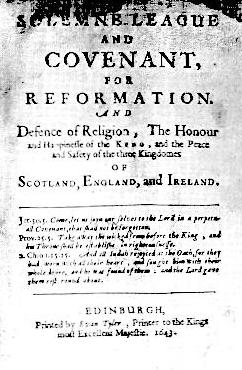
The Solemn League and Covenant was an agreement between the Scottish Covenanters and the leaders of the English Parliamentarians in 1643 during the First English Civil War, a theatre of conflict in the Wars of the Three Kingdoms. On 17 August 1643, the Church of Scotland accepted it and on 25 September 1643 so did the English Parliament and the Westminster Assembly.

The Irish Confederate Wars, also called the Eleven Years' War, took place in Ireland between 1641 and 1653. It was the Irish theatre of the Wars of the Three Kingdoms, a series of civil wars in the kingdoms of Ireland, England and Scotland – all ruled by Charles I. The conflict had political, religious and ethnic aspects and was fought over governance, land ownership, religious freedom and religious discrimination. The main issues were whether Irish Catholics or British Protestants held most political power and owned most of the land, and whether Ireland would be a self-governing kingdom under Charles I or subordinate to the parliament in England. It was the most destructive conflict in Irish history and caused 200,000–600,000 deaths from fighting as well as war-related famine and disease.

The Wars of the Three Kingdoms were a series of related conflicts fought between 1639 and 1653 in the kingdoms of England, Scotland and Ireland, then separate entities united in a personal union under Charles I. They include the 1639 to 1640 Bishops' Wars, the First and Second English Civil Wars, the Irish Confederate Wars, the Cromwellian conquest of Ireland and the Anglo-Scottish war (1650–1652). They resulted in victory for the Parliamentarian army, the execution of Charles I, the abolition of monarchy, and founding of the Commonwealth of England, a Unitary state which controlled the British Isles until the Stuart Restoration in 1660.
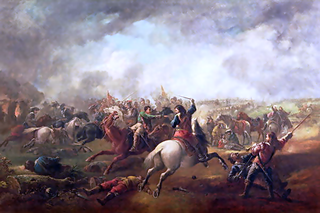
The First English Civil War took place in England and Wales from 1642 to 1646, and forms part of the 1639 to 1653 Wars of the Three Kingdoms. They include the Bishops' Wars, the Irish Confederate Wars, the Second English Civil War, the Anglo-Scottish war (1650–1652) and the 1649 to 1653 Cromwellian conquest of Ireland. Historians estimate that between 15% to 20% of all adult males in England and Wales served in the military between 1639 to 1653, while around 4% of the total population died from war-related causes. This compares to a figure of 2.23% for World War I, which illustrates the impact of the conflict on society in general and the bitterness it engendered.
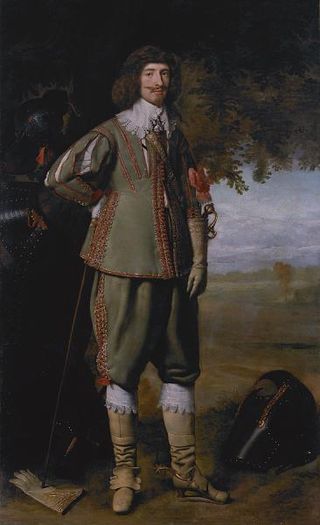
John Ashburnham was an English courtier, diplomat and politician who sat in the House of Commons at various times between 1640 and 1667. He supported the Royalist cause in the English Civil War and was an attendant on the King.
Francis Leigh, 1st Earl of Chichester was a Royalist politician and courtier around the period of the English Civil War.
The Committee for Plundered Ministers was appointed by the Long Parliament, then under the influence of the Presbyterians, after the start of the English Civil War in August 1643 for the purpose of replacing and effectively silencing those clergy who were loyal to King Charles I.
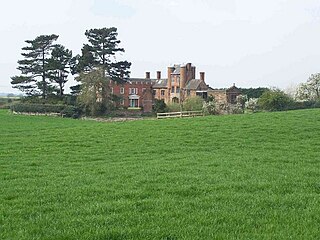
Sir Edward Littleton, 1st Baronet was a 17th-century English Baronet and politician from the extended Littleton/Lyttelton family, the first of a line of four Littleton baronets with Pillaton Hall as their seat. He initially joined the Parliamentarians during the English Civil War. Having tried unsuccessfully to find a third way, he switched his support to the Royalist cause – a decision that led to his financial ruin, as large debts made it impossible to redeem his estates from sequestration after the victory of Parliament.

The 1639 and 1640 Bishops' Wars were the first of the conflicts known collectively as the 1639 to 1653 Wars of the Three Kingdoms, which took place in Scotland, England and Ireland. Others include the Irish Confederate Wars, the First and Second English Civil Wars, the Anglo-Scottish war (1650–1652), and the Cromwellian conquest of Ireland.
In 1643, near the start of the English Civil War, Parliament set up two committees the Sequestration Committee which confiscated the estates of the Royalists who fought against Parliament, and the Committee for Compounding with Delinquents which allowed Royalists whose estates had been sequestrated, to compound for their estates – pay a fine and recover their estates – if they pledged not to take up arms against Parliament again. The size of the fine they had to pay depended on the worth of the estate and how great their support for the Royalist cause had been.
Sir Charles Dallison was a gentleman from Lincolnshire who served as an officer in the Royalist army during the English Civil War. He was also a serjeant-at-law, and in 1648 he published an often cited pamphlet justifying his reasons for supporting the Royalist cause.
Captain Sir Thomas Liddell, 1st Baronet (1578–1652) was an English politician, a member of the Liddell family which monopolized the local government of the North of England during the 16th and 17th centuries. He was one of the leading supporters of the Royalist cause in the English Civil War.
Humphrey Mackworth was an English lawyer, judge, and politician of Shropshire landed gentry origins who rose to prominence in the Midlands, the Welsh Marches and Wales during the English Civil War. He was the Parliamentarian military governor of Shrewsbury in the later phases of the war and under The Protectorate. He occupied several important legal and judicial posts in Chester and North Wales, presiding over the major trials that followed the Charles Stuart's invasion in 1651. In the last year of his life, he attained national prominence as a member of Oliver Cromwell's Council and as a Member of the House of Commons for Shropshire in the First Protectorate Parliament.
This is a timeline of events leading up to, culminating in, and resulting from the Wars of the Three Kingdoms.
Sir Anthony Morgan of Kilfigin, Monmouthshire, was a Royalist officer during the English Civil War.

The 1641 Army Plots were two separate alleged attempts by supporters of Charles I of England to use the army to crush the Parliamentary opposition in the run-up to the First English Civil War. The plan was to move the army from York to London and to use it to reassert royal authority. It was also claimed that the plotters were seeking French military aid and that they planned to seize and fortify towns to become Royalist strongholds.

Sir Humphrey Bennet (1605–1667) was a Hampshire landowner who fought for the Royalists in the First English Civil War, in which he rose to the command of a cavalry brigade. He went into exile in 1645, returned home in 1646 and was active in a number of Royalist conspiracies during The Protectorate.
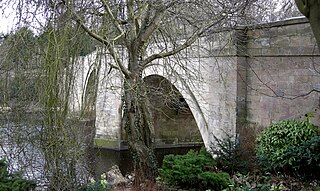
The Battle of Piercebridge was fought on 1 December 1642 in County Durham, England, during the First English Civil War. The Earl of Newcastle was advancing with an army of 6,000 from Newcastle upon Tyne to York to reinforce the local Royalists. Aware of his approach, the Parliamentarians defended the main crossing over the River Tees, at Piercebridge. Under the command of Captain John Hotham, around 580 troops had barricaded the bridge.
References
- ↑ Calendar of the Proceedings of the Committee for Advance of Money, 1642–1656C. H. Firth Review; The English Historical Review, Vol. 5, No. 20 (Oct., 1890), pp. 791–792
- 1 2 3 Calendar of the Committee for Advance of Money (3 vols) (1888); M.A.E. Green (ed)
- ↑ Ancestral Trails: The Complete Guide to British genealogy and family history; Mark D. Herber p542